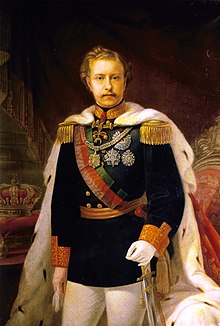Ludwig I (Portugal)
Ludwig I (Portuguese Dom Luís Filipe Maria Fernando Pedro de Alcântara António Miguel Rafael Gabriel Gonzaga Xavier Francisco de Assis João Augusto Júlio Valfando de Saxe-Coburgo-Gotha e Bragança ) (born October 31, 1838 in Lisbon ; † October 19, 1889 in Cascais ) was King of Portugal from the House of Saxe-Coburg and Gotha and ruled from 1861 to 1889. Before taking office, he had the title of Duke of Porto.
Life
Ludwig was the second son of Queen Maria II of Portugal and her husband Ferdinand II. Due to the early death of his older brother Peter V , who died childless, Ludwig came to the throne in 1861. The circumstances of his accession to the throne were not happy, because apart from his older brother, who was popular with the people as a king and who had succumbed to an epidemic of fever, two younger brothers of Ludwig died of the same disease within a short time.
Ludwig is the only king of Portugal who has ever commanded a ship during his military service. He made his love for shipping clear by founding the Museu de Marinha in Lisbon.
In António Maria de Fontes Pereira de Melo, Ludwig had a capable head of government who especially pushed the industrialization of Portugal. But after he lost power in 1886 and died the following year, the end of Ludwig's reign was overshadowed by problems. There was a momentous dispute with Great Britain over colonial policy in southern Africa. At that time Portugal went public with the plan to combine its two colonies in West and East Africa (today's Mozambique and Angola ) in order to establish a large cohesive colonial empire. Unfortunately, Great Britain had a similar plan, wanting to merge its African colonies in a north-south direction, from Egypt to South Africa (→ Cape Cairo plan ). However, Portugal could not compete economically or militarily with Great Britain. So, given the real balance of power, the Portuguese had no choice but to give in to British pressure and abandon their plan.

The plan had sparked great nationalist enthusiasm among the Portuguese public, and the disappointment when it had to be abandoned was correspondingly great. For the first time, not only the government but the king and the monarchy themselves were blamed for Portugal's weakness. In the final phase of Ludwig's reign, therefore, republican currents grew for the first time . Although these were not yet strong enough to seriously endanger the monarchy, the foundation stone was laid for the development that would lead to the catastrophe for the monarchy under Ludwig's successor .
The Ponte Dom Luís I , which connects Porto to Vila Nova de Gaia, is named after him.
Marriage and offspring
King Ludwig I married Princess Maria Pia of Savoy , a daughter of King Victor Emmanuel II of Italy , in 1862 . With this he had two children:
- Charles I (September 28, 1863 - February 1, 1908), King of Portugal
- Alfons Heinrich (born July 31, 1865 - † February 21, 1920), Duke of Porto
See also
literature
- Albano Anthero da Silveira Pinto: Resenha das familias titulares e grandes de Portugal. Lisbon 1883, p. XIV, LXVI.
- Adolf von Deitenhofen: Foreign princes in the Habsburg army 1848–1898. Im Selbstverlage, 1898, pp. 586–588.
Web links
Individual evidence
- ↑ Revista da Armada: Jaime do Inso ( Memento of August 14, 2007 in the Internet Archive ) (Portuguese), accessed on June 12, 2012
| predecessor | Office | successor |
|---|---|---|
| Peter V. |
King of Portugal 1861–1889 |
Charles I. |
| personal data | |
|---|---|
| SURNAME | Ludwig I. |
| ALTERNATIVE NAMES | Louis I of Portugal; Ludwig of Saxe-Coburg-Gotha |
| BRIEF DESCRIPTION | King of Portugal (1861-1889) |
| DATE OF BIRTH | October 31, 1838 |
| PLACE OF BIRTH | Lisbon , Portugal |
| DATE OF DEATH | October 19, 1889 |
| Place of death | Cascais , Portugal |

